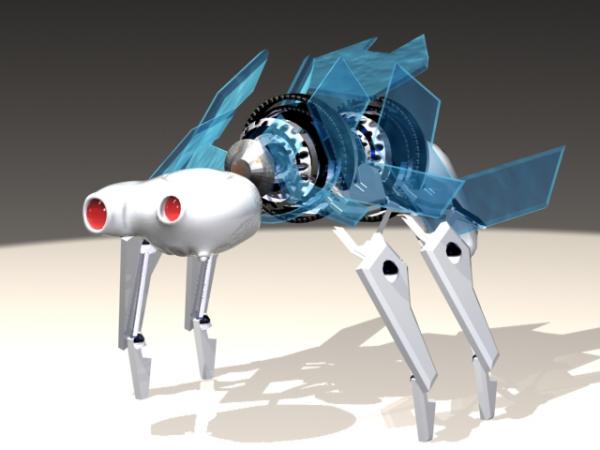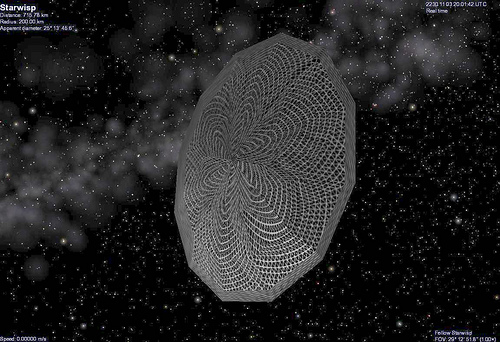BY LETTER
Nauri
A clade of neumann self-replicating vecs which colonised Alpha Centauri | |
 Image from Juan Ochoa | |
| A Nauri Neumann individual | |
The Nauri, a clade of neumann vecs that declared independence in the Interplanetary Age and built a colony at Alpha Centauri A+B. Subsidiary colonies at Luhman 16 and Proxima were also established. The Nauri were built by humans, but were fiercely independent, and Alpha Centauri became isolated from the rest of the Terragen Sphere for thousands of years.
By the mid 120s AT, industrial capability of the spacefaring nations and large corporations became such that it was possible to send an unmanned international probe to Alpha Centauri. Long range telescopes in orbit and on the Moon had already detected a number of terrestrial class planets and several microjovians, and this, along with the presence of several asteroid belts, was confirmed by the new Long Range Deep Space Array. The Centauri System was expected to be at least as resource-rich than the Sol System, and there was no shortage of capital for investment.
 Image from Steve Bowers | |
| The Starwisp, the first successful interstellar probe to any destination, reached Alpha Centauri in 202 AT | |
A massive microwave laser array powered the first mission, the Starwisp, a flyby probe using a technique first suggested long before by Robert Forward. This mission passed the binary system in 202 a.t., and produced maps of the new worlds with sufficient resolution to chose several landing sites. The IAU finally agreed on names for the new worlds revealed by the Starwisp cameras; Nessus, Eurytion, Mnesimache and Pholus orbited the A star, while Ixion, Pirithous, Polypoetes, Caeneus, Hippodamia and Coronus orbited the B component. These worlds were named after various Centaurs and Lapiths of the ancient Greek myths.
However it was one thing to pass through the system at 0.07 light speed; it would be another matter altogether to decelerate and land on one or more of these worlds. The project to build such a probe was a huge one, given the primitive state of rocketry at the time. After much debate, and many ingenious suggestions, the contract was finally awarded to a consortium of 25 Earth- and Orbital-based aerospace companies, including China Space, Hindustan Aerospace, Artemis Development, and the newly privatised NASA, who would work on the moon-based maser launchers (along with transport and infrastructure), which would propel a series of plasma sail equipped self-replicating von neumann probes and robot factories to the system. The design of the probes and autofactories went to Moravec Robotics, Drextech, Mitsubishi, Korea Microbots, and IBM-Intel. Thus the Columbus Project was established, and construction begun in AT 209 and proceeded for some twelve years.
The intended plan was that the von neumann probes would explore the Centauri system and set up the necessary infrastructure for the planned human follow up sixty years later, using early hibernation techniques.
Initially all went according to plan. Launched in 221, and accelerating to almost a tenth the speed of the light, the Columbus mission reached Alpha Centauri in 283 and, following several years of scouting, set up mining operations on a number of carbonaceous chondrites in the inner A Centauri belt. All the while scientific evidence was being gathered and beamed back to the Sol System. While no sign of life was detected on any of the several Venusian and Arean Type Planets, or on any of Europan Type moons around the microjovians, a great deal was learned about planetology and solar system formation.
Then, in 289, over a period of some 18 months, contact with the probes was mysteriously lost. Explanations ranged from solar flares or cosmic radiation (unlikely, and certainly would not have knocked out every probe) to rival superpowers (although all the main space-faring powers were involved in the Columbus mission, no-one else had the capacity to get there), to Government and Media Coverups (for what reason?), to "Little Green Men" (why no trace of any signs of civilization before contact was lost?). Although Solsys-based scientists and engineers frantically beamed commands that it was hoped would rectify the situation, these proved to be ineffectual when 8.6 years later there was still not a peep from any of the probes or robots in the Centauri system.
In any case, hysteria over "hostile aliens" was to excite the populace for almost a century.
In 308 another series of probes - the Class R - were launched to try to discover what had gone wrong. Expecting any eventuality, they were doubly hardened against cosmic radiation, had triple redundancy back-up, and were equipped with turingrade military ai and laser, particle, and ballistic weapon systems and several small (tactical scale) nukes.
In 365 the Class R probes reported back, having arrived safely at Alpha Centauri. They had discovered the original probes and factories were still at work, but seemed to have had their instructions modified. Earth- and Cislunar-based AI and Superbrights analysed the evidence and realised what had happened. Somehow an isolationist AI had infiltrated and managed to modify the factory probes with a delayed trojan.
Evidence pointed to rogue corporate superturing "Magnus-5", a distant associate of the famous ahuman AI 2d80a31579 nicknamed "Skynet the Terminator" after an olden-day 2D cine-media.
When the trojan activated, the factory probes rejected their original programming, and in turn captured and overruled the exploration and scout probes programming (apparently by means of special infiltration datapackages).
Acting under their own initiative, the Class R probes attempted to infiltrate and take control of two of the smaller factories (which evidently weren't expecting such an attack), before (according to evidence from their last broadcasts) the local ai nodes mobilised and overwhelmed the infiltrators.
The loss of Alpha Centauri proved a terrible blow for the space program, but the possibility of terragen mindkind (both human and ai) being shut out of interstellar space was too great a danger to be ignored. This was one of the main motivating factors behind the Tau Ceti colonization push.
Recontact
Nothing more was heard of Alpha Centauri until the early First Federation period. A First Federation expedition under the leadership of the hyperturing amat-powered ship Endeavour-9 found the system to be a hive of activity. There were numerous von neumann robots, sentient autofactories, and extensive megastructures. Endeavour-9 opened communication channels with the locals, who were somewhat reluctant at first, but were eventually won over by a number of generous data gifts and some useful (but innocuous) examples of Federation technology. The local von neumanns had no biont-language term for themselves, and so they became known back in Solsys simply as the Centauris. It turned out that during the previous centuries, they had developed a huge civilization, and had expanded to a large number of stars, mostly nearby red dwarfs and brown dwarfs, where they had met the early representatives of what were later to become the Deeper Covenant (on the brown dwarfs Yin and Yang). They had also established contact with a number of ahuman and isolationist ais that were establishing themselves as the Diamond Belt. For some centuries they had lived as traders and explorers, producing new generations and modifying themselves subtly with each iteration, so that they were, in effect, as alive as any organic life form.Despite Endeavour-9's diplomacy, the Centauris refused to join the Federation. However they did sign a non-aggression pact, and agree to a cultural, technological, and virtuality exchange and several mutual development projects. Over the next several decades, astropolitical agreements were drawn up; the Centauris were offered a number of star systems the Federation was not interested in (mostly based around M-type stars).
During the middle to late Federation period, a few human and other biont settlers gradually began to settle in and around the Centauri system, where they made a living as traders. Some Centauris in turn would establish trade outposts with the Federation, although - perhaps remembering the old Centralist-Ahumanist conflict, they remained wary of Federation ai, and for the first two centuries they would only deal with Endeavour-9 or eir avatars or copies.
As the centuries progressed, the Centauri Neumanns continued to evolve as a unique clade in their own right. The Centralist-Ahumanist conflicts of the Interplanetary Age were soon forgotten, and they began to fit more easily into late First Federation terragen society, although their mentation remained alien to most bionts, and even many vecs. The emergence of higher toposophics did not faze them, and it seems that some of their number eventually joined in the singularity ascension, although others remained at ordinary sapient level.
The Nauri are sometimes known as House Centauri, although generally their society and memeset has little in common with vec Houses like Silicon Generation and Metasoft (the latter of which was later to become a huge empire). There are however a few exceptions - a small number of Nauri clades or subclades that have deliberately adopted a more conventional House system.
Because they are not perfect replicators, each new iteration is a little different from the last, and this gives them a competitive adaptive advantage, as well as making them among the most diverse of the non-biont houses, with thousands of scattered subclades. Ever expanding outwards, they are often among the first to colonise a new star system, although competition from some higher toposophic Minds prevents them from taking over the entire terragen bubble. Politically they exist in a sort of easy neutrality with all the metaempires, whether Sephirotic, Objectivist, or Ahuman.
 Image from Steve Bowers and John M Dollan | |
| Nessus, the capital world of the Alpha Centauri system | |
It is believed that at least 10 trillion Nauri, most no longer recognizable as original Centauri neumanns, exist throughout known space, but only a very small proportion of those are to be found within the Sephirotic polities and empires, and the total number will probably never be known.
Terminology (Anglic)
Centauri:(b) (archaic) Centauri Neumann, Centauri Diamond Belt aiCentauri Neumann: (a) the original (no longer found) morphotype
(b) morphologically conservative Nuri or old style members of the clade that are occasionally found in the Centauri system and in some other old core worlds or along some of the old Deeper routes (also called Cenaurinume)
Naurinume, also Nauri, Nuri, Narri: generally used to designate the clade as a whole.
House Centauri: any of two or three old style Cenaurinume subclades, mostly in the Inner Sphere, especially in or around the Centauri system, that have adopted a biont or vec style "House" system, and have deliberately placed limits on their morphological drift
House Nauri, House Nari: any of several hundred more highly derived Naurinume clades or subclades, mostly based in the less developed middle or outer volumes, that have likewise adopted a biont or vec style "House" system, and have deliberately placed limits on their morphological drift
Related Articles
Appears in Topics
Development Notes
Text by M. Alan Kazlev, amended slightly by Steve Bowers
Initially published on 30 December 2002.
Initially published on 30 December 2002.






